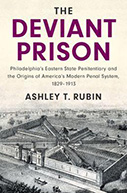The Deviant Prison: Philadelphia’s Eastern State Penitentiary and the Origins of America’s Modern Penal system, 1829-1913

Author: Ashley T. Rubin
Publisher: Cambridge University Press, 2021. 320 pages
Reviewer: Mary Gibson ǀ November 2021
Ashley Rubin has written a welcome and illuminating account of Eastern State Penitentiary, which is well-known in prison history as the model for the “Pennsylvania” system of punishment. While its principles of prisoner rehabilitation are familiar even to undergraduate students of criminal justice history, surprisingly few scholarly works have focused on the actual practices at Eastern State. The Deviant Prison begins to fill this gap by providing a detailed and well-researched chronology of the devolution of this famous institution from its establishment in 1829, as the utopian incarnation of the Pennsylvania model, through a long period when these principles were weakened in practice and legally abolished in 1913.
Also labelled the “solitary” or “separate” system, the Pennsylvania model of prison reform, like the rival Auburn model, focused on the importance of architecture to remold the mind of the offender. In contrast to earlier jails, where inmates were crowded together in large dormitories, the Pennsylvania system required individual cells in which inmates would pass both their days and nights. Although the panopticon model proposed by Jeremy Bentham, which envisioned floors of separate cells in a semi-circular pattern, was particularly well-known in the late eighteenth and early nineteenth centuries, few of the new penitentiaries were built in this architectural shape. Instead, most Pennsylvania-style penitentiaries adopted a floorplan of separate wings radiating from a central tower, from which guards could control all cells through, in Foucault’s phrase, their “gaze.” Inmates slept and worked in their cells, with only short periods of recreation in individual exercise yards. According to proponents, the goal of this spatial arrangement was not retribution but rather reform through isolation, allowing inmates to reflect on their misdeeds and preventing their contact with corrupt companions. It also assured anonymity to prisoners, who were referred to only by number and hooded when moved around the facility; again, this impersonal treatment was not intended to be cruel, but instead to protect their identity, and therefore reputation, when reentering society after release.
That Eastern State adopted the Pennsylvania system, with pride and publicity, and clung doggedly to its principles for over eighty years made it, according to Rubin, a “deviant prison.” Based on sociological theories of “organizational deviance” and “neoinstitutionalism,” she argues that Eastern State was an “abnormal, but not necessarily harmful” institution because it defied the trend among other penitentiaries to adopt the Auburn model of prison reform (p. xxxviii). This alternate model, also called the “congregate” or “silent” system, required isolation only at night while days were spent in silent labor in large workshops. While historians may find Rubin’s elaborate social science framework unnecessary, she successfully establishes that despite its theoretical fame within the United States, very few states adopted the Pennsylvania system, and those that did usually abandoned it as unworkable or deleterious. Her main question thus becomes, why did Eastern State refuse to give in to the penological consensus about the superiority of the Auburn model, but instead fervently defended both the righteousness and the practicality of its initial institutional design?
Rubin’s answer focuses on the role of the prison administrators at Eastern State, who included inspectors, wardens, physicians, and “moral instructors,” who counseled inmates in their cells. Often ignored in prison histories that instead emphasize the power of reform theories or criminal law, administrators indeed deserve attention, and it is a merit of this book to cast them as central players rather than simply mechanical bureaucrats. Liminal figures who occupy a space between the policy-makers on the outside and the inmates (and guards) on the inside, administrators often hold broad discretionary powers over the actual implementation of reform philosophies as a lived experience. They might wield decisive influence over the access of prisoners to education and work, the frequency of punishment and rewards, the behavior of guards, the quality of health care, and the timing of release, in the case of parole. Drawing on their annual reports, Rubin argues that the administrators at Eastern State perpetuated the Pennsylvania system mainly to preserve their status within the organization. They turned Eastern State’s “deviancy” into a strength that elevated their power over the management of punishment above that of both local prison reform societies, and government at the city and state levels. With unusual energy and passion, Eastern State’s administrators defended their unpopular system in reports, during tours by foreign dignitaries, and at early penological conferences. Defense of the Pennsylvania system turned into a fervent crusade.
Rubin follows the history of Eastern State through three phases, the second of which forms the core of the book. First, she analyzes the period of the “proto-prison,” beginning in the 1780s, to locate the roots of the Pennsylvania system. While this period has been widely studied, beginning with David Rothman’s pioneering book of 1971, the Discovery of the Asylum, Rubin finds earlier explanations for the birth of the penitentiary insufficient. In her view, Rothman did not recognize the uniqueness of the Pennsylvania system in his argument that fears of social disorder motivated Jacksonian America to replace the increasingly ineffective social control of family and community with an array of institutions of enclosure. Neither does the influence of Quakerism convince Rubin, who points out that reform societies in other states included Quakers, and that not all administrators at Eastern State were Quakers. Instead, the dramatic failure of proto-prisons, such as the Walnut Street Prison in Philadelphia, explained the fevered search for a new paradigm. Modernized between 1789 and 1794, the Walnut Street Prison differentiated itself from dysfunctional colonial jails by replacing the traditional private “keeper,” who charged inmates for their upkeep, with a public warden paid by the state. Useful work was introduced to reform and train inmates and solitary confinement to ensure discipline. By 1820, however, Walnut Street was overwhelmed with disorder, caused by overcrowding, and besieged by criticism of solitary confinement as brutal and inhuman. Eastern State, therefore, was born out of crisis and struggle, as its founders doubled down on solitary confinement as a cure, rather than the cause of the collapse of Walnut Street.
The glory years of Eastern Penitentiary, between 1829 to 1870, constitute the main section of the book, which traces the successful campaign of its administrators to establish and defend the Pennsylvania system. Rubin offers a portrait of the most important administrators, whom she describes as “gentlemen reformers” with roots in the city’s elite families (p. 71). Having no professional training in prison management, they nevertheless threw themselves into defending Eastern State, which came immediately under attack within its first decades. In their annual reports to the state legislature, administrators sought to disprove the “myths” perpetuated by their opponents, who favored the Auburn system. These “myths” held that the Pennsylvania system was too expensive, since individual cells could accommodate only old-fashioned artisanal work as opposed to factory labor or construction. Another “myth” demonized solitary confinement as cruel and detrimental to inmates’ physical and mental health. And finally, critics branded the Pennsylvania system as ineffective in reforming prisoners and preparing them for social re-integration after release. Relying on their own statistics, Eastern State’s administrators insisted that their institution made a profit; that health conditions were good; and that recidivism had declined among their inmates. For their part, they made counterclaims about the fatal weaknesses of the Auburn system, which included the corruption inherent in systems of factory labor managed by private contractors; the use of whipping to discipline disorderly inmates; the high number of escapes; and, most importantly, the moral contamination of first-time offenders by their more hardened companions. Rubin characterizes Eastern State’s administrators as tireless crusaders because they identified themselves with the institution and their status with the perpetuation of its founding principles.
The final section of the book traces the internal collapse and final demise of the Pennsylvania model. Through sleuthing into the Warden’s Daily Journal and other documents not meant for public consumption, Rubin finds that Eastern State began to violate its own theory for decades before 1913, when the legislature officially substituted a new organizational regime. Most notably, Rubin found examples of “double-celling” and “out-of-cell work,” both of which violated the foundational concept of strict separation of inmates (pp. 208, 213). Increased instability during the Civil War and its aftermath led to escalating overcrowding, violence, and escapes. Most importantly, for Rubin’s thesis, the Pennsylvania/Auburn conflict, which had animated its administrators for decades, became irrelevant as penology became professionalized, and the Irish system—which moved inmates, based on good behavior, through stages of both “separate” and “congregate” living—gained popularity. The “gentlemen reformers” of Eastern State lost status and visibility within the new world of international congresses, dominated by figures such as Enoch Wines and Zebulon Brockway, who were educated in the new “prison science” that stressed the biological and psychological determinants of criminality. As the original administrators retired, their replacements increasingly bureaucratized Eastern State and based their claims to status on professionalization rather than defense of the Pennsylvania model. Therefore, after 1900 the founding philosophy became a legal fiction covering a radically different administrative structure.
Because of its integration of both sociological and historical methodology, Deviant Prisons will appeal to a wide range of scholars interested in criminal justice. However, it also leaves some questions unanswered and ripe for future research. First, do the annual reports and other administrative documents of Eastern State provide enough detail to reconstruct the everyday life of inmates? A social history from the bottom up would nicely complement Rubin’s analysis from the heights of the administration. Second, the book provides tantalizing details about the inclusion of women and African-Americans among the prison population, but does not offer an extended gender or racial analysis of the place of these groups in the penological ideology of Eastern State. Finally, from a transnational perspective, the Pennsylvania system may not have constituted such an anomaly. For example, the separate system began to be implemented in Tuscany in the 1830s and became a requirement for all penal institutions in its Criminal Code of 1853; soon after the unification of Italy in 1861, solitary confinement was adopted for all short-term jails. During the nineteenth century, Belgium also initiated a building campaign of Pennsylvania-style penitentiaries. The lively European debates about the merits of the separate system and its adoption outside of the United States will make Rubin’s book of keen interest to an international audience, and constitutes an important contribution to the expanding field of the history of prisons, transportation, and penal colonies.
Mary Gibson is a Professor Emerita of History at John Jay College and the Graduate Center City University of New York


